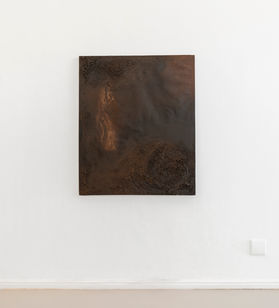SIMPHIWE BUTHELEZI
Imvuselelo Yenkululeko
EXHIBITION TEXT
Solo Exhibition
08.02.20 – 17.05.20
Stellenbosch
What does freedom look like? Those of the ‘born free’ generation, like Buthelezi, know well that liberation narratives alone do little to foster change when systems of disparity remain unchecked. Rather than become disillusioned, however, Buthelezi uses her practice to understand freedom as a nascent possibility, an ever-unraveling process. What are its terms? What are its boundaries? What is its landscape? What is freedom’s domain, and how might it be cultivated?
Icansi, or a hand-woven straw mat, is the symbol at the centre of this interrogation. For Buthelezi, the straw mat is a multi-layered, and often contradictory, object. Both domestic and spiritual, commodity and tradition, artifact and archetype, the mat becomes the site of cultural and temporal overlap. Operating here, Buthelezi creates work that, though subtle and delicate, bears witness to the often overlooked histories that this material represents.
Buthelezi is particularly interested in the mat as an intergenerational object. Mats are passed down through a family as heirlooms; the technique for weaving them is a long-standing indigenous art practice. Buthelezi sees them as ‘remnants’ or ‘fragments’ of a history which has been distorted by colonial legacies. What might we make of this history in the post-colonial moment, when so much of it has been hidden, extracted, robbed, fragmented, lost? What might be uncovered by re-performing the same gestures that ‘craftsmen’, many of whom arewomen, have been practicing for centuries? What is revealed when the material is taken seriously? Buthelezi invites us to imagine the mat and the many hands present in the weaving and mending of it as something salvaged, a living archive. Experimenting with new forms of weaving—as well as juxtaposing the straw with ornate gilded picture frames, beads, and oxidised metal—Buthelezi both recuperates what may have been lost from the tradition, and instils it with new life.
Central to Buthelezi’s practice is an investment in women’s lives—not just their bodies or their labour, but the rich landscape of their internal worlds. In a world where women’s bodies bear the brunt of patriarchal violence—both physically and institutionally—how do women find rest? How do women find safety? How do women take ownership over their bodies and identities? Instead of depicting their figures and forms, Buthelezi’s work commemorates the moments when women stop, reflect, and unwind. “I hope to immerse people into a woman’s deep contemplation,” Buthelezi says, “how she plans and executes survival and finds rest.” It’s in these moments—where women create space for themselves and each other to heal—that Buthelezi gets the sense of what freedom might look like: “A metaphysical and physical space which is safe from intrusion… a space where my body or mind cannot be intruded or oppressed.”
This is the aim at the core of Buthelezi’s work: not to create art objects, per se, but to create space for the viewer. Space to pause. Space to reconnect. Space to make a go at introspection or empathy. In this way, we might think about the straw mat as a metaphor for shelter, and Buthelezi’s intervention on the medium as an invitation for the viewer to take refuge. If this is the domain of freedom, it can be understood only in flux. Constantly shifting, constantly re-negotiated, constantly becoming.
Text by Keely Shinners





















